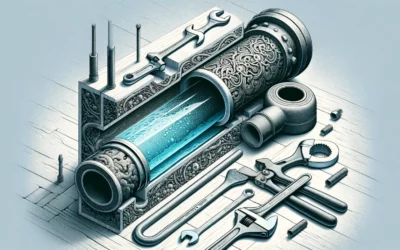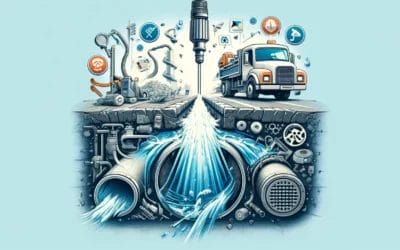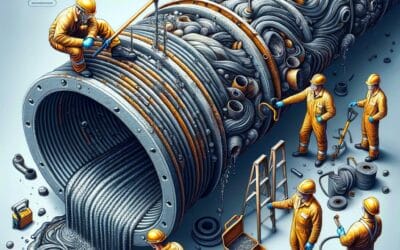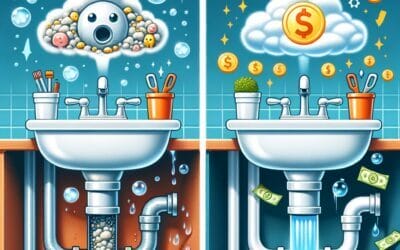Welcome to our engaging post titled “Understanding the Prevalence of Sewer Backups: An Insight”. This educational read is designed to provide a comprehensive overview of why sewer backups are common and the core reasons behind them. Derived from expert opinions and evidence-based facts, our in-depth guide aims to arm you with valuable knowledge to better manage such issues should they arise. By understanding the key factors and common causes, you can take effective preventive measures, ultimately reducing the impact and inconvenience of such incidents. This piece is more than informative; it’s a pivotal resource for safeguarding your property. Let’s delve into the world of sewer systems for practical, applicable insights!
Understanding the Causes of Sewer Backups
Sewage backups are not only a significant inconvenience, but they also pose a threat to your health and property. Multiple factors can contribute to this problem. Clogs and blockages are among the most common. This occurs when inappropriate elements such as fats, oils, hair, and other undissolvable substances build up in the pipes. In domestic setups, the issue is usually due to flushing down materials such as diapers and sanitary napkins that are not designed to disintegrate. Another cause linked to sewage backups is leakage resulting from aging and degraded sewer lines. As these lines wear out, they become susceptible to leaks or complete breaks, leading to sewage spilling out.
Besides the direct issues with the sewer line, external factors can also contribute significantly. For instance, heavy rains and floods can overwhelm the sewer system, causing backups. A sudden or steady influx of water can overload the system, causing the wastewater to flow backward into your property. There are additional factors such as tree root infiltration into sewer lines and municipal sewer malfunctions that can also lead to backups. It’s also worth noting that incorrect pipe installation and design can lead to problematic flow and thereby, backups.
- Clogs and blockages: Accumulation of inappropriate elements in the pipes
- Aging and degraded sewer lines: Leads to leaks or complete breaks
- Heavy rains and floods: Can overwhelm the sewer system
- Tree root infiltration: Roots can break into and block sewer lines
- Municipal sewer malfunctions: Problems at the broader system level can lead to backups at your property
- Incorrect pipe installation and design: Can lead to problematic flow and thereby backups
Without insight into these causes, handling and preventing sewage backups can be a daunting task. But understanding the potential reasons and being vigilant can prevent potential damage and ensure the smooth running of your property’s sewer system.
Know the Impacts of Sewer Backups on Urban Environments
As the urban sprawl expands, so too does the prevalence of sewer backups – a problem with significant bearings on both human health and the environment. One of the key harmful impacts of such issues is water pollution. When sewer systems backup, untreated wastewater can overflow into our streets and waterways. This sewage contains harmful bacteria, viruses, and other pathogens that pose a serious threat to public health and can disrupt local ecosystems. Furthermore, the pollutants in this water can contaminate our groundwater, the source of drinking water for many.
- Spread of Diseases – When untreated sewage spills onto streets and other public areas, it can act as a breeding ground for harmful bacteria and viruses. These pathogenic threats can lead to illnesses such as cholera, dysentery, and hepatitis when in contact with humans.
- Damage to Buildings and Infrastructure – Sewer backups can also cause serious structural damage. As the wastewater seeps into the ground, it can undermine the foundations of buildings and roads, leading to costly repairs and significant disruption.
- Decrease in Property Value – Areas prone to sewer backups could see a reduction in property values due to the potential for damage and health risks. This can lead to economic instability in affected communities.
Sewer backups also wreak havoc on local wildlife. The introduction of pollutants can harm or even kill animals and disrupt food chains, leading to broader ecological issues. As our cities continue to grow, the need for effective wastewater management becomes increasingly important.
| Impact | Explanation |
|---|---|
| Water Pollution | Sewage overflows can contaminate our streets, waterways, and even our groundwater supply. |
| Ecosystem Disruption | Untreated sewage can harm local wildlife and disrupt established food chains. |
| Economic Instability | The potential for damage and health risks can drive down property values in affected areas. |
This is why it is crucial for cities to invest in robust and reliable sewer management solutions, capable of keeping up with urban expansion and minimizing the risk of sewer backups.

Recognizing the Symptoms and Effects of Sewer Backups in Homes
If you’ve ever experienced a sewer backup in your home, you know just how unpleasant it can be. Aside from the obvious sanitary hazards, there are multiple, less apparent effects to be aware of. Recognizing the signs, from foul odors to unusual noises, is the first step to swiftly deal with this disruptive issue.
Odors and Visible Signs
The earliest evidence of a sewer backup often presents itself as a strange, unpleasant smell wafting from drains and pipes. This odor, similar to rotten eggs, is hard to ignore and can quickly permeate your home. In addition, look out for bubbling water in toilets or sinks. You may also spot water backing up in showers, tubs, and basins, often dark in color and potentially carrying traces of waste. Ultimately, if multiple drains and fixtures are clogged at once, it is highly likely you are dealing with a sewer backup issue.
| Symptom | Problem Indicated |
|---|---|
| Unpleasant Smell | Possible Sewer Backup |
| Bubbling Water | Water’s Pathway Blocked |
| Water Backing Up | Sewage Overflow |
Sewer backups, if not handled promptly, can cause significant damage to your home. They can lead to structural damage to floors, walls, and furniture touched by wastewater and may even induce mold growth due to increased humidity. The hazards aren’t just physical, but health-related too. Exposure to sewer gases can cause nausea, dizziness, headaches, and in severe cases, respiratory or neurological problems.
| Effect | Potential Damage |
|---|---|
| Structural Damage | Floors, Walls, Furniture |
| Mold Growth | Increased Humidity |
| Sewer Gas Exposure | Health Issues |
By recognizing these symptoms and understanding the potential damage, you can act swiftly to address a sewer backup, minimizing its effects on your home and health. Always remember that seeking professional help is the most effective solution to ensure your home is safe and sanitary.

Investigating the Role of Municipal Infrastructure in Sewer Backups
Every urban dweller is no stranger to the frustrating experience of sewer backups, a menace that not only brings about considerable damage to property but also poses significant health risks. An essential player in the occurrence of these disruptions is municipal infrastructure. This setup, which consists of the physical and organizational structures, facilities, and services needed for the functioning of a community, often contributes to sewer issues due to various factors.
- Ageing infrastructure - Many city systems are siting on a network of ageing pipes. An old system is more likely to have cracks or be corroded, leading to blockage or complete failure.
- Lack of regular maintenance and repair – Regular assessment of the conditions of sewer systems tends to be overlooked, resulting in preventable problems being left to accumulate until it’s too late.
- Inadequate capacity – With urban population numbers on the rise, the volume of waste that needs to be processed has also increased. Unfortunately, many city systems do not have the capacity to handle this swell, resulting in persistent backups.
Improving the state of municipal infrastructure is crucial in preventing frequent sewer backups.
| Municipal Infrastructure Issue | Recommended Action |
|---|---|
| Ageing Infrastructure | Upgrade and replace old pipes |
| Lack of Maintenance | Implement a regular inspection and repair scheme |
| Inadequate Capacity | Invest in expanding and enhancing the sewer system scalability |
Further, a call for city heads and local governments to invest in technology that could help in monitoring and predicting potential sewer issues is growing. Investing in infrastructure isn’t just about the visible roads, bridges, or buildings, but also the essential unseen system underground that significantly impacts the quality of urban life.
Emphasizing the importance of preventative measures, including regular cleaning and addressing infrastructure issues efficiently, can significantly improve the situation and lessen instances of sewer blockage. We can only hope that with collective patience and understanding, effective strategies can be implemented to curb this pressing issue.
Profound Insights from Experts on Sewer Backups
Our society heavily depends on sewer systems to transport waste water away from homes and business establishments. However, despite the indispensable role these systems play, sewer backups remain a pervasive problem. What triggers them? According to wastewater treatment experts, the leading culprits include blocked sewer pipes, collapsed lines, excessive rainwater infiltration, and tree roots intruding into sewer lines. Blocked sewer pipes tend to be predominantly caused by inappropriately discarded materials. Items like nappies, wet wipes, and non-flushable items act as the catalyst for these backups. On the other hand, collapsed lines typically occur in older houses where the sewer system has inevitably aged. Infrastructure gets old and vulnerable, thereby giving way to collapses. Moreover, excessive rainwater inflicts pressure on the sewage system, particularly when proper stormwater systems are missing or inadequate. Lastly, tree roots have a natural tendency to seek water and can inadvertently impale the sewer lines causing blockages. In light of this, preventative measures and proper maintenance are essentials in mitigating the risk of these backups.
- Regular sewer line inspections with cameras can help detect and clear blockages early.
- Replacing aging infrastructure with modern and more durable materials can prevent line collapses.
- Development of adequate stormwater systems can manage excessive rainwater.
- Being mindful of what you flush down toilets can also significantly reduce the likelihood of blockages.
- Keeping trees and large plants at a respectable distance from sewer lines can prevent root intrusion.
Despite adopting these measures, sewer backs are not always avoidable. Thus, homeowners and businesses need to invest in insurance that covers sewer backup. The water and wastewater treatment sector experts stress that having this shield can spare you the financial hardship that backups often impose.
| Common Causes of Sewer Backups | Preventative Measures |
| Blocked sewer pipes | Regular sewer line inspections |
| Collapsed lines | Infrastructure replacement |
| Excessive rainwater | Development of stormwater systems |
| Tree root intrusion | Distance trees from sewer lines |

Precautionary Measures to Prevent Sewer Backups
Sewage backing up into your home can be more than just an inconvenience. It can lead to potentially costly repairs, health issues, and damage to your property. As such, it is important to consider several precautionary steps to safeguard your home against such a mishap. Adequate knowledge and regular maintenance can help you avoid this messy situation.
| Preventive Measure | Explanation |
|---|---|
| Proper Trash Disposal | Avoid flushing anything other than human waste and toilet paper. These items can cause blockages, leading to sewage backups. |
| Regular Inspection | Have a professional inspect and clean your lateral pipeline at least once every two years. This can catch potential issues before they cause a backup. |
| Backwater Valve Installation | Consult with a professional plumber about installing a backwater valve. This device allows sewage to go out, but not back in. |
Apart from these, consider using grease-fighting liquid detergents in your kitchen and installing grates over your home’s drain openings to prevent unwanted objects from entering your drain system. The roots of large trees can cause damage to your sewer pipes, so think about where you plant those saplings or significantly large trees. In particular, you might consider enlisting the help of a landscaping professional to ensure that tree roots do not interfere with your home’s sewage system. Regular checks on your home’s sewage system can help you remain proactive, and timely responses will minimize damage in case of a sewage backup.
Practical Solutions and Recommendations for Sewer Backups Management
Staying on Top of Sewer Maintenance
Sewer backup can cause significant damage to your property rendering your home uninhabitable. Regular maintenance can significantly reduce the chance of this unfortunate event. Here are a few straightforward precautions anyone can implement:
- Dispose of Grease Properly: Never pour grease down your sink or toilet. Grease is a common cause of sewer backups as it solidifies in pipes, causing blockages. Instead, store grease in a separate container and throw it away with your usual waste.
- Implement Regular Pipe Maintenance: Utilise professional sewer cleaning services every 18 to 22 months. This helps to eliminate any potential blockages and keeps your sewer lines functioning optimally.
- Consider a Backwater Prevention Valve: This valve is installed into a sewer line in the basement to prevent sewer backups. They allow sewage to go out, but not to come back in.
When a Backup Occurs – Effective Response Measures
In the unfortunate event of a sewer backup, prompt and decisive action is crucial. Besides immediate contact with a professional cleaning service, homeowners can take other steps to mitigate damage and facilitate restoration efforts:
| Action | Description |
|---|---|
| Secure the Area | Limit access to the affected area to prevent the risk of health hazards associated with sewer backups. |
| Document the Damage | Take photos and videos of the affected area before cleanup for insurance purposes. |
| Contact Your Insurance Company | Most insurance policies cover sewer backup damages to a certain extent. Promptly reporting the incident to your insurer can speed up the claims process. |
The proactive measures outlined above together with a rapid reaction strategy in the event of a sewer backup can help to significantly reduce property damage and related expenses.
Closing Remarks
In closing, sewer backups remain a crucial topic that homeowners need to be aware of, as they not only pose a significant threat to property but also to health. It’s important to understand the severity of sewer backups and take the necessary steps to prevent them from occurring. Armed with the insights from this article, you should feel better prepared to understand the prevalence and risks associated with sewer backups and take proper preventative measures. Remember, knowledge is power, and in this case, it could save you from a disastrous, unsanitary mess. Together, let’s keep our homes secure and our environments clean.









